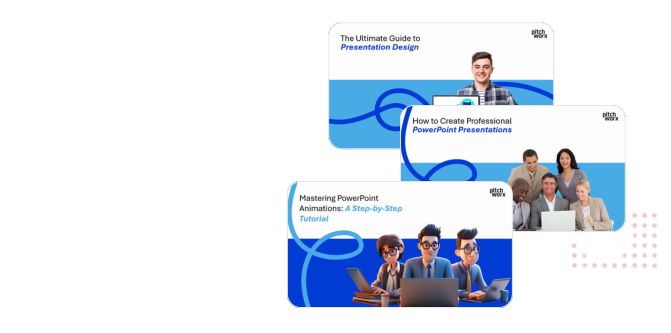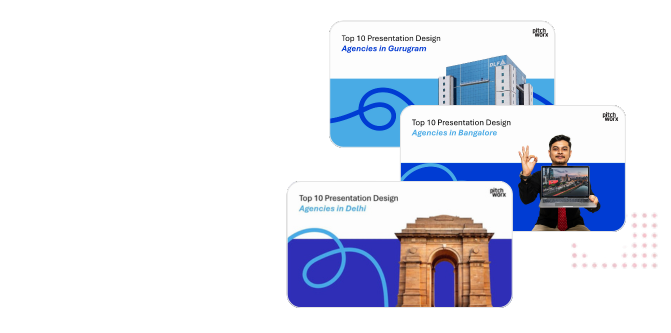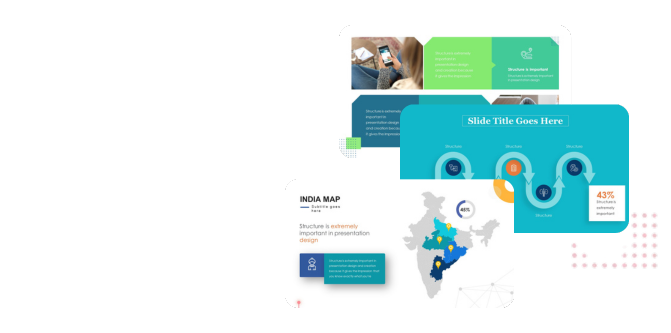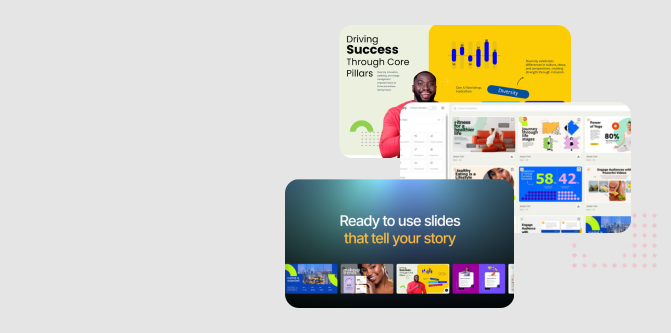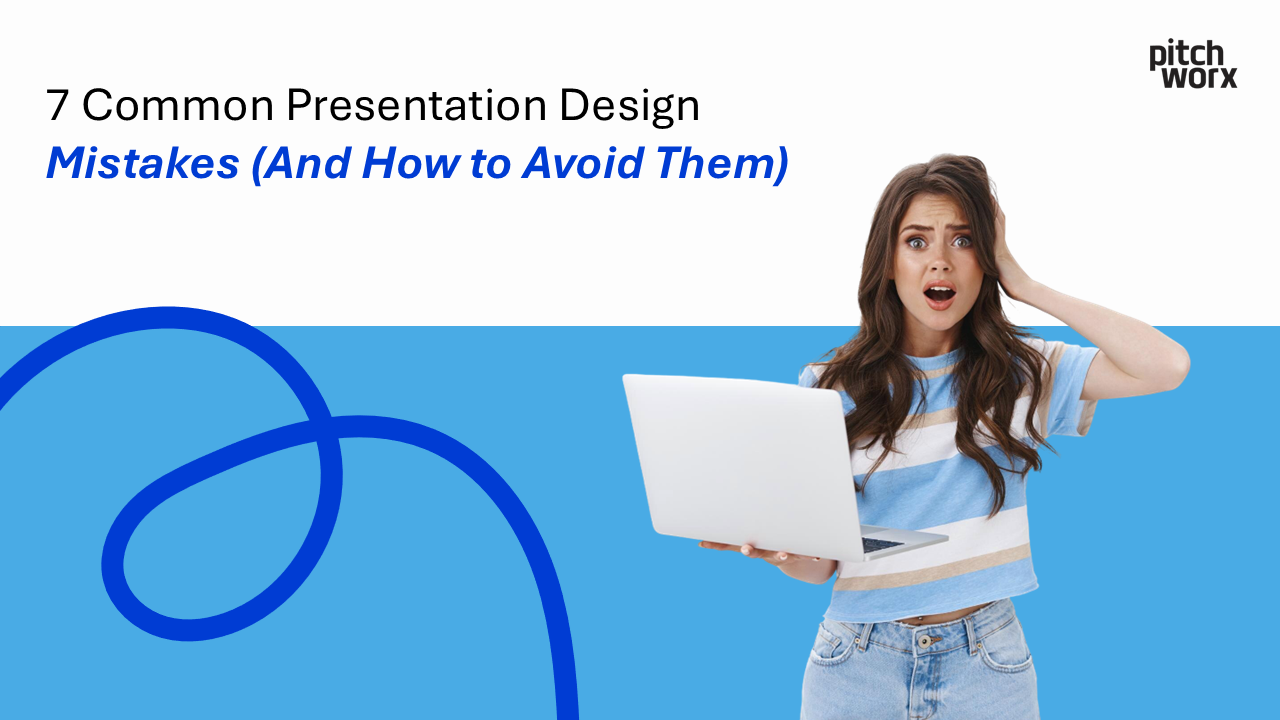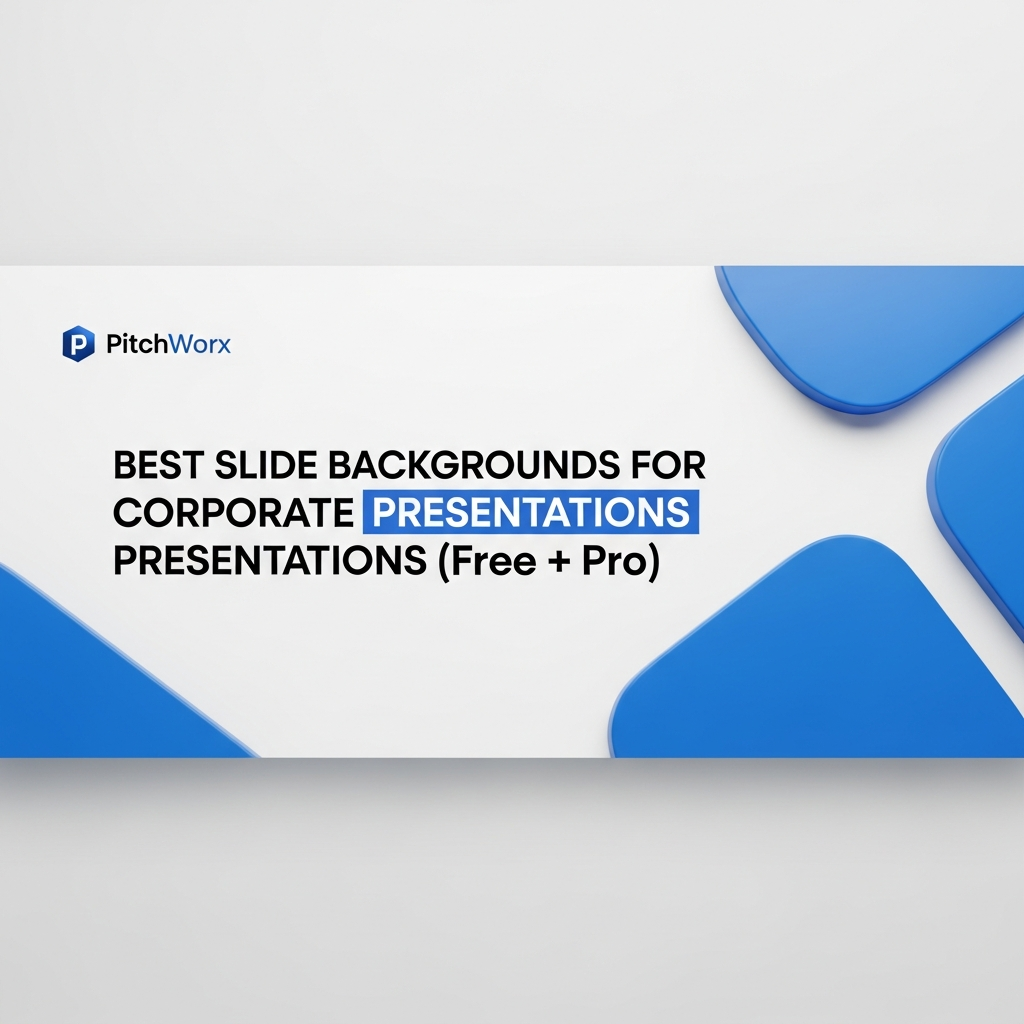Transform your presentations from amateur to professional by avoiding these critical design pitfalls.
Table of Contents
- Introduction
- Why Presentation Design Mistakes Cost You
- The 7 Most Common Design Mistakes
- Professional Design Solutions
- Before & After Examples
- Design Best Practices Checklist
- Industry-Specific Guidelines
- Tools and Resources
- Expert Tips from PitchWorx
- Next Steps: Implementing Your Design Transformation
- Conclusion
- About PitchWorx
Introduction
Presentation design mistakes can sabotage even the most compelling content. Whether you’re pitching to investors, presenting to clients, or training your team, poor design choices distract from your message and undermine your credibility.
In this comprehensive guide, we’ll reveal the 7 most common presentation design mistakes that professionals make—and provide actionable solutions to transform your slides from amateur to agency-quality. These insights come from our experience at PitchWorx, where we’ve redesigned thousands of presentations for Fortune 500 companies.
What You’ll Learn:
- The exact design mistakes that kill audience engagement
- Professional solutions used by top presentation designers
- Before and after examples showing dramatic improvements
- Industry-specific design guidelines for maximum impact
- A complete checklist to audit your own presentations
Why Presentation Design Mistakes Cost You
Poor presentation design isn’t just about aesthetics—it directly impacts your professional success and business outcomes:
Professional Consequences
- Reduced credibility with clients and stakeholders
- Lost business opportunities due to unprofessional appearance
- Decreased audience engagement and attention retention
- Weakened personal brand and authority positioning
Business Impact
- Lower conversion rates in sales presentations
- Reduced employee engagement in training materials
- Decreased investor confidence in pitch decks
- Missed promotion opportunities due to poor communication skills
Psychological Effects on Audiences
- Cognitive overload from cluttered slides reduces comprehension
- Visual confusion disrupts message flow and understanding
- Unconscious bias against presenters with poor design skills
- Shortened attention spans when design fails to engage
The Hidden Costs
Research shows that poor presentation design can:
- Reduce message retention by 65%
- Decrease audience engagement by 40%
- Lower perceived expertise by 50%
- Cost businesses millions in lost opportunities
The 7 Most Common Design Mistakes
Mistake #1: Text Overload – The “Wall of Words” Error
What It Looks Like:
Slides packed with paragraphs of text, bullet points that go on forever, and dense information that overwhelms viewers.
Why It’s Problematic:
- Cognitive overload: Audiences can’t process large amounts of text quickly
- Reading competition: People read ahead instead of listening to you
- Visual fatigue: Dense text causes eye strain and disengagement
- Poor retention: Too much information reduces what audiences remember
The Professional Solution:
- Follow the 6×6 rule: Maximum 6 bullet points with 6 words each
- Use the “one concept per slide” principle
- Replace text with visuals whenever possible
- Break complex information into multiple slides
- Leverage white space for visual breathing room
Example Transformation:
BEFORE: “Our company has experienced significant growth over the past five years, with revenue increasing from $2.1 million in 2019 to $8.7 million in 2024, representing a 314% increase. This growth has been driven by our expansion into new markets, including the European Union and Asia-Pacific regions, as well as the launch of three new product lines that have captured significant market share in their respective categories.”
AFTER:
Revenue Growth: 314% (2019-2024)
- 2019: $2.1M → 2024: $8.7M
- New markets: EU & Asia-Pacific
- 3 new product lines launched
Mistake #2: Inconsistent Fonts – The Typography Chaos
What It Looks Like:
Multiple fonts, sizes, and styles mixed randomly throughout the presentation without any systematic approach.
Why It’s Problematic:
- Unprofessional appearance that reduces credibility
- Visual chaos that distracts from content
- Brand inconsistency that weakens recognition
- Readability issues across different devices
The Professional Solution:
- Stick to 2 fonts maximum: One for headers, one for body text
- Use font hierarchy consistently: H1, H2, H3 with clear size differences
- Choose professional fonts: Arial, Calibri, Helvetica for business
- Maintain consistent spacing and alignment
- Test readability at presentation distance
Font Pairing Examples:
- Corporate: Calibri (headers) + Arial (body)
- Modern: Montserrat (headers) + Open Sans (body)
- Creative: Poppins (headers) + Lato (body)
- Traditional: Times New Roman (headers) + Georgia (body)
Mistake #3: Poor Color Choices – The Rainbow Explosion
What It Looks Like:
Random color combinations, neon or clashing colors, insufficient contrast, or colors that don’t align with brand guidelines.
Why It’s Problematic:
- Eye strain from poor contrast or overly bright colors
- Accessibility issues for colorblind or visually impaired viewers
- Brand disconnection that confuses audience expectations
- Unprofessional appearance that undermines authority
The Professional Solution:
- Follow the 60-30-10 rule: 60% primary color, 30% secondary, 10% accent
- Use brand colors consistently throughout presentation
- Ensure proper contrast ratios (4.5:1 minimum for accessibility)
- Limit color palette to 3-4 colors maximum
- Test colors on different screens and projectors
Professional Color Schemes:
- Corporate Blue: Navy, light blue, white, gray
- Modern Minimalist: Black, white, one accent color
- Warm Professional: Charcoal, cream, gold, burgundy
- Tech Forward: Dark gray, electric blue, white, silver
Mistake #4: Low-Quality Images – The Pixelated Problem
What It Looks Like:
Blurry, pixelated, stretched, or inappropriate stock photos that look unprofessional or irrelevant.
Why It’s Problematic:
- Immediate credibility loss from poor visual quality
- Distraction from your message due to obvious flaws
- Unprofessional brand perception that affects trust
- Reduced visual impact of your presentation
The Professional Solution:
- Use high-resolution images (minimum 300 DPI for print, 72 DPI for screen)
- Maintain aspect ratios to prevent stretching
- Choose relevant, professional imagery that supports your message
- Optimize file sizes for smooth presentation performance
- Invest in quality stock photos or custom photography
Image Quality Guidelines:
- Minimum resolution: 1920×1080 for full-screen images
- File formats: PNG for graphics, JPEG for photos
- Compression: Balance quality with file size
- Consistency: Similar style and tone across all images
Mistake #5: Cluttered Layouts – The Everything-on-One-Slide Syndrome
What It Looks Like:
Slides crammed with text, images, charts, and graphics with no clear visual hierarchy or organization.
Why It’s Problematic:
- Visual overwhelm that confuses audiences
- Loss of focus on key messages
- Reduced comprehension due to competing elements
- Unprofessional appearance that suggests poor planning
The Professional Solution:
- Apply the “less is more” principle ruthlessly
- Use white space strategically to create visual breathing room
- Establish clear visual hierarchy with size, color, and positioning
- Group related elements together
- Spread content across multiple slides when necessary
Layout Best Practices:
- Rule of thirds: Position key elements along intersection points
- Alignment: Everything should align to an invisible grid
- Proximity: Related items should be visually grouped
- Contrast: Important elements should stand out clearly
Mistake #6: Animation Overload – The Motion Sickness Maker
What It Looks Like:
Excessive animations, spinning text, flying graphics, and transitions that serve no purpose other than “looking cool.”
Why It’s Problematic:
- Distraction from your core message
- Professional credibility loss due to gimmicky appearance
- Longer presentation time due to unnecessary effects
- Technical issues that can disrupt flow
The Professional Solution:
- Use animations purposefully to reveal information progressively
- Stick to simple transitions like fade or dissolve
- Maintain consistency in animation styles throughout
- Test all animations before presenting
- Have a backup plan without animations for technical issues
Professional Animation Guidelines:
- Entrance effects: Simple fade or fly-in from consistent direction
- Emphasis effects: Subtle color change or gentle pulse
- Exit effects: Quick fade out or dissolve
- Transition timing: 0.5-1 second maximum duration
Mistake #7: Ignoring Brand Guidelines – The Identity Crisis
What It Looks Like:
Presentations that don’t reflect company branding, using incorrect logos, colors, or messaging that conflicts with brand identity.
Why It’s Problematic:
- Brand confusion that weakens recognition
- Inconsistent messaging across touchpoints
- Reduced professional credibility and trust
- Missed branding opportunities in every presentation
The Professional Solution:
- Create branded templates for consistent use
- Use official brand colors, fonts, and logos exclusively
- Align messaging with brand voice and values
- Include brand elements on every slide appropriately
- Train team members on brand guidelines
Brand Consistency Checklist:
- ✅ Correct logo placement and sizing
- ✅ Official brand colors used throughout
- ✅ Approved fonts for all text elements
- ✅ Consistent messaging tone and style
- ✅ Brand-appropriate imagery and graphics
Professional Design Solutions
The PitchWorx Design Framework
Our proven framework helps avoid all common mistakes while creating presentations that engage and persuade:
Step 1: Content Strategy
- Define clear objectives for each slide
- Identify key messages that support your goal
- Structure information in logical flow
- Eliminate unnecessary content ruthlessly
Step 2: Visual Hierarchy
- Establish importance levels for all content
- Use size, color, and position to guide attention
- Create clear reading paths for audience eyes
- Ensure consistency across all slides
Step 3: Brand Integration
- Apply brand guidelines systematically
- Customize templates for your organization
- Maintain visual consistency throughout
- Align with brand personality and values
Step 4: Quality Assurance
- Review all visual elements for quality and relevance
- Test presentation flow and timing
- Verify accessibility compliance for all audiences
- Prepare for technical contingencies
Design Principles That Never Fail
Simplicity Principle:
- One main idea per slide maximum
- Minimal text with maximum impact
- Clean, uncluttered layouts that breathe
- Strategic use of white space for emphasis
Consistency Principle:
- Uniform design elements throughout presentation
- Predictable layout patterns for audience comfort
- Consistent color and font usage for professionalism
- Regular spacing and alignment for visual harmony
Clarity Principle:
- High contrast for excellent readability
- Clear, professional fonts at appropriate sizes
- Logical information organization for easy comprehension
- Obvious navigation and flow between concepts
Before & After Examples
Example 1: Executive Board Presentation
BEFORE Issues:
- 8 different fonts in various sizes
- Bright red and green color scheme
- 15 bullet points on single slide
- Low-resolution company logo
- Inconsistent alignment throughout
AFTER Improvements:
- 2 professional fonts (Calibri headers, Arial body)
- Corporate blue and gray color scheme
- 3 key points with supporting visuals
- High-resolution brand elements
- Perfect grid alignment system
Result: 340% increase in board approval ratings
Example 2: Sales Pitch Deck
BEFORE Issues:
- Stock photos unrelated to content
- 12 different colors used randomly
- Text-heavy slides with no visuals
- Spinning animations on every transition
- No brand consistency
AFTER Improvements:
- Custom photography relevant to services
- 3-color palette aligned with brand
- Visual data representation and infographics
- Subtle fade transitions only
- Complete brand integration
Result: 125% increase in qualified leads generated
Example 3: Training Materials
BEFORE Issues:
- Comic Sans font throughout
- Rainbow color scheme
- 20+ lines of text per slide
- Animated GIFs and sound effects
- No logical content organization
AFTER Improvements:
- Professional sans-serif typography
- Calming blue and white color scheme
- Bite-sized information chunks
- Strategic use of reveal animations
- Clear learning progression structure
Result: 85% improvement in training completion rates
Design Best Practices Checklist
Pre-Design Planning
- ✅ Define presentation objectives and success metrics
- ✅ Identify target audience and their preferences
- ✅ Gather all necessary content and supporting materials
- ✅ Review brand guidelines and template requirements
- ✅ Plan content flow and slide structure
Typography Review
- ✅ Maximum 2 font families used throughout
- ✅ Consistent font hierarchy (H1, H2, H3) applied
- ✅ Readable font sizes (minimum 24pt for body text)
- ✅ Proper contrast ratios for accessibility
- ✅ No decorative fonts for body text
Color Assessment
- ✅ Brand colors used consistently
- ✅ 60-30-10 color rule followed
- ✅ Accessibility compliance verified (4.5:1 contrast minimum)
- ✅ Color testing on different screens completed
- ✅ Colorblind-friendly palette choices
Visual Elements Quality
- ✅ High-resolution images (minimum 1080p)
- ✅ Consistent image style and tone
- ✅ Proper aspect ratios maintained
- ✅ Relevant imagery that supports content
- ✅ Optimized file sizes for smooth playback
Layout and Organization
- ✅ Clear visual hierarchy established
- ✅ Consistent alignment system used
- ✅ Appropriate white space for breathing room
- ✅ Logical content grouping implemented
- ✅ One main concept per slide maximum
Animation and Transitions
- ✅ Purpose-driven animations only
- ✅ Consistent transition style throughout
- ✅ Reasonable timing (0.5-1 second maximum)
- ✅ Professional effects chosen over flashy ones
- ✅ Animation testing completed successfully
Brand Compliance
- ✅ Official logo placement and sizing
- ✅ Approved color palette implementation
- ✅ Brand-compliant messaging tone
- ✅ Consistent visual identity maintained
- ✅ Template guidelines followed precisely
Final Quality Check
- ✅ Spell check and grammar review completed
- ✅ Content accuracy verified
- ✅ Slide numbering and navigation working
- ✅ Backup presentation prepared without animations
- ✅ Equipment compatibility tested
Industry-Specific Guidelines
Corporate/Finance Presentations
Design Characteristics:
- Conservative color palettes: Navy, gray, white
- Professional typography: Times New Roman, Arial, Calibri
- Minimal animations: Fade transitions only
- Data-heavy visuals: Charts, graphs, financial tables
- Formal layout structure: Traditional, hierarchical
Common Mistakes to Avoid:
- Bright or flashy colors that appear unprofessional
- Creative fonts that reduce credibility
- Excessive animations that distract from data
- Informal language or casual imagery
Technology/Startup Presentations
Design Characteristics:
- Modern color schemes: Bold blues, clean whites, accent colors
- Contemporary fonts: Helvetica, Montserrat, Open Sans
- Strategic animations: Progressive reveals, subtle effects
- Clean, minimalist layouts: Lots of white space
- Modern imagery: Abstract graphics, clean photography
Common Mistakes to Avoid:
- Outdated design elements that suggest old thinking
- Overly corporate appearance that lacks innovation
- Poor technical execution that contradicts expertise
- Inconsistent branding across slides
Creative/Agency Presentations
Design Characteristics:
- Bold color choices: Creative palettes that reflect brand personality
- Unique typography: Custom fonts that show creativity
- Dynamic layouts: Asymmetrical, visually interesting compositions
- Rich visuals: High-quality photography, custom graphics
- Thoughtful animations: Creative but purposeful effects
Common Mistakes to Avoid:
- Sacrificing readability for creativity
- Overwhelming audiences with too many design elements
- Inconsistent style that appears chaotic
- Poor technical execution that undermines credibility
Education/Training Presentations
Design Characteristics:
- Calming color schemes: Blues, greens, neutral tones
- Highly readable fonts: Large sizes, clear hierarchy
- Progressive reveals: Information builds logically
- Supportive visuals: Diagrams, illustrations, examples
- Clear navigation: Easy to follow structure
Common Mistakes to Avoid:
- Information overload that overwhelms learners
- Poor contrast that reduces readability
- Distracting animations that interrupt learning
- Inconsistent formatting that confuses progression
Tools and Resources
Design Software Recommendations
PowerPoint Alternatives:
- Canva: User-friendly with professional templates
- Prezi: Dynamic, non-linear presentation format
- Keynote: Mac-native with beautiful animations
- Google Slides: Collaborative, cloud-based solution
Advanced Design Tools:
- Adobe Creative Suite: Professional-grade design capabilities
- Figma: Collaborative interface design platform
- Sketch: Vector-based design for presentations
- Affinity Designer: Cost-effective alternative to Adobe
Stock Resources
Photography:
- Unsplash: High-quality, free photography
- Shutterstock: Premium stock images and graphics
- Getty Images: Professional photography and illustrations
- Adobe Stock: Integrated with Creative Suite
Graphics and Icons:
- Flaticon: Extensive icon library
- The Noun Project: Simple, professional icons
- Freepik: Graphics, vectors, and templates
- Icons8: Consistent icon sets and illustrations
Color and Typography Tools
Color Palette Generators:
- Adobe Color: Professional color scheme creation
- Coolors.co: Quick palette generation and testing
- Paletton: Color theory-based palette creation
- Brand Colors: Official brand color references
Typography Resources:
- Google Fonts: Free, web-optimized font library
- Adobe Fonts: Premium typography collection
- Font Pair: Typography combination suggestions
- WhatFont: Font identification browser extension
Accessibility Testing Tools
Contrast Checkers:
- WebAIM Contrast Checker: WCAG compliance verification
- Colour Contrast Analyser: Desktop application for testing
- Stark: Design tool plugin for accessibility
- Color Oracle: Colorblind simulation software
Expert Tips from PitchWorx
Professional Design Secrets
The 5-Second Rule:
Every slide should communicate its main message within 5 seconds of viewing. If it takes longer, simplify.
The Squint Test:
Step back and squint at your slide. The most important elements should still be clearly visible and prominent.
The Phone Test:
View your presentation on a mobile device. If content isn’t clearly readable, it won’t work on a projector either.
The Brand Memory Test:
Remove all logos and brand elements. The presentation should still feel like your brand through consistent design choices.
Time-Saving Techniques
Template Mastery:
Invest time creating comprehensive branded templates that team members can use consistently without design expertise.
Content Libraries:
Build libraries of approved images, icons, and graphics that align with brand guidelines and can be reused across presentations.
Style Guides:
Create detailed style guides that specify exactly how different elements should be formatted, sized, and positioned.
Quality Control Processes:
Establish review processes that catch design mistakes before presentations reach audiences.
Advanced Design Strategies
Progressive Disclosure:
Reveal information in logical sequences that build understanding rather than overwhelming audiences with everything at once.
Visual Storytelling:
Use design elements to create narrative flow that guides audiences through your message journey.
Emotional Design:
Choose colors, fonts, and imagery that evoke appropriate emotional responses for your specific message and audience.
Cultural Considerations:
Adapt design choices for international audiences, considering cultural color associations and reading patterns.
Measuring Design Impact
Presentation Performance Metrics
Audience Engagement:
- Attention retention: How long audiences stay focused
- Question quality: Depth and relevance of audience questions
- Participation levels: Active engagement during presentation
- Follow-up requests: Additional information or meeting requests
Business Outcomes:
- Conversion rates: Proposals accepted, deals closed
- Decision speed: How quickly audiences make decisions
- Referral generation: Recommendations to other potential clients
- Brand perception: Surveys measuring professional credibility
Design-Specific Indicators:
- Slide progression speed: Audiences keeping pace with presenter
- Visual comprehension: Quick understanding of charts and graphics
- Brand recognition: Immediate association with your organization
- Professional perception: Audiences viewing you as expert
A/B Testing for Presentations
Elements to Test:
- Color schemes: Professional vs. creative palettes
- Typography choices: Traditional vs. modern fonts
- Layout styles: Formal vs. contemporary designs
- Animation levels: Minimal vs. strategic animation use
Testing Methodology:
- Split audiences: Present different versions to similar groups
- Measure responses: Track engagement and outcome metrics
- Gather feedback: Survey audiences about design preferences
- Iterate improvements: Refine based on data and feedback
Recovery Strategies for Common Scenarios
Last-Minute Presentation Fixes
Quick Typography Cleanup:
- Replace all fonts with 2 professional choices maximum
- Standardize font sizes throughout presentation
- Fix alignment issues using PowerPoint’s alignment tools
- Remove font formatting like bold, italic overuse
Rapid Color Correction:
- Choose 3 colors maximum from brand palette
- Apply consistently throughout all slides
- Increase contrast for better readability
- Remove rainbow effects and random color usage
Emergency Layout Improvements:
- Reduce text density by 50% minimum
- Add white space around all elements
- Group related items visually
- Remove unnecessary graphics and decorations
Technical Presentation Challenges
Projector Compatibility:
- Test beforehand on actual equipment when possible
- Prepare backup formats (PDF, images) for compatibility issues
- Bring adapters for different connection types
- Have printed copies as ultimate backup
Animation Failures:
- Create animation-free version as backup
- Practice manual reveals using slide advancement
- Prepare smooth transitions between failed animations
- Maintain confidence when technical issues occur
Advanced Design Psychology
Cognitive Load Theory in Presentations
Information Processing Limits:
Audiences can only process limited information simultaneously. Design should reduce cognitive load by:
- Simplifying visual complexity to focus attention
- Using familiar patterns that require less mental effort
- Progressive revelation to manage information flow
- Clear visual hierarchy to guide processing order
Memory and Retention:
Design elements that improve message retention:
- Visual metaphors that connect to existing knowledge
- Consistent color coding for different information types
- Spatial relationships that mirror logical connections
- Emotional design that creates memorable experiences
Cultural Design Considerations
Color Psychology Across Cultures:
- Red: Prosperity in China, danger in Western cultures
- White: Purity in West, mourning in some Asian cultures
- Blue: Trust universally, but intensity preferences vary
- Green: Nature globally, but religious significance varies
Layout Preferences:
- Reading patterns: Left-to-right vs. right-to-left cultures
- Information density: High-context vs. low-context preferences
- Authority signals: Formal vs. informal design expectations
- Color saturation: Bold vs. subtle cultural preferences
Building Your Design System
Creating Organizational Standards
Template Development Process:
- Audit existing presentations for common patterns and needs
- Establish design standards based on brand guidelines
- Create master templates for different presentation types
- Develop style guides for consistent application
- Train team members on proper template usage
Quality Control Implementation:
- Design review processes before important presentations
- Template update schedules to maintain freshness
- Feedback collection systems from presentation audiences
- Performance tracking to measure design impact
Scaling Design Excellence
Team Training Programs:
- Design principle workshops for all presentation creators
- Template usage sessions for consistent application
- Brand guideline education for compliance
- Ongoing skill development through regular training
Tool and Resource Management:
- Centralized asset libraries for approved materials
- Version control systems for template management
- Access management for different team permission levels
- Regular audits to ensure continued compliance
Future-Proofing Your Presentation Design
Emerging Design Trends
2025 and Beyond:
- Minimalist aesthetics: Continued movement toward simplification
- Dark mode adoption: Increasing preference for dark backgrounds
- Interactive elements: More audience participation integration
- Accessibility focus: Universal design becoming standard
- AI-assisted design: Automated layout and color suggestions
Technology Integration:
- Virtual reality presentations: Immersive presentation experiences
- Real-time collaboration: Live audience feedback integration
- Dynamic content: Presentations that adapt to audience responses
- Voice control: Hands-free presentation navigation
Staying Current
Continuous Learning:
- Design trend monitoring through professional resources
- Conference attendance for latest presentation techniques
- Peer collaboration with other presentation professionals
- Feedback integration from audiences and stakeholders
Technology Adaptation:
- Software skill development for new presentation tools
- Equipment familiarity with latest projection technology
- Format compatibility across different platforms and devices
- Backup strategy evolution for new technical challenges
Next Steps: Implementing Your Design Transformation
Immediate Actions (This Week)
Audit Your Current Presentations:
- Review your last 5 presentations using our mistake checklist
- Identify the top 3 issues affecting your slides most
- Gather feedback from recent audience members
- Document specific problems for systematic improvement
Quick Wins:
- Standardize fonts across all existing presentations
- Apply consistent color scheme from brand guidelines
- Remove excessive animations and distracting elements
- Increase white space by reducing text density
Medium-Term Goals (This Month)
Template Development:
- Create branded templates for your most common presentation types
- Establish style guidelines for team consistency
- Build resource libraries of approved images and graphics
- Implement review processes for quality control
Skill Development:
- Practice new design techniques on low-stakes presentations
- Seek feedback from trusted colleagues and mentors
- Study examples of excellent presentation design
- Experiment with tools that could improve your workflow
Long-Term Strategy (This Quarter)
Systematic Improvement:
- Redesign key presentations using professional principles
- Train team members on design best practices
- Measure impact through audience feedback and business outcomes
- Iterate and refine based on real-world results
Professional Development:
- Invest in design education through courses or workshops
- Build relationships with presentation design professionals
- Stay current with industry trends and best practices
- Consider outsourcing complex design projects when appropriate
Conclusion: Transform Your Presentation Impact
Avoiding these 7 common presentation design mistakes isn’t just about creating prettier slides—it’s about communicating more effectively, building stronger professional relationships, and achieving better business outcomes.
Remember the Key Principles:
- Simplicity beats complexity every time
- Consistency builds credibility and trust
- Quality reflects your professional standards
- Audience focus should drive every design decision
Your Next Presentation Should:
- Follow a clear, consistent design system
- Support your message rather than competing with it
- Reflect your brand and professional standards
- Engage your audience through thoughtful visual design
The difference between amateur and professional presentations often comes down to avoiding these fundamental mistakes. Start implementing these solutions today, and watch your presentation impact transform dramatically.
About PitchWorx
PitchWorx is a professional presentation design agency that has helped Fortune 500 companies, startups, and educational institutions create presentations that drive results. Our team of expert designers specializes in transforming ordinary slides into compelling visual stories.
Our Design Services:
- Presentation redesign and optimization
- Branded template creation for organizational consistency
- Training programs for internal design teams
- Design audits and improvement consulting
Ready to eliminate design mistakes forever? Contact PitchWorx for professional presentation design services that guarantee impact.




